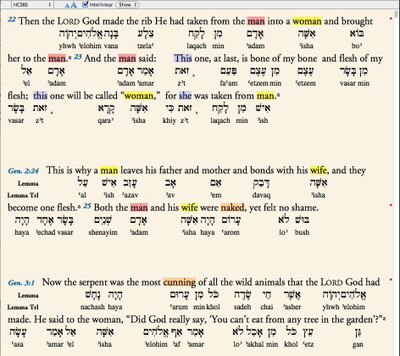Ever heard a preacher or read a commentary which identified some subtle play on words in the original Greek or Hebrew? That kind of literary artistry, which depends on similarities in the sound or spelling of the original words, is very difficult to duplicate in translation. After all, two words that sound alike in Hebrew may have English counterparts which sound totally different.
Don’t you wish you could pick up on those kinds of things when you study the Bible? Of course you do! But there’s the little matter of needing to become fluent in Greek and Hebrew first. Here’s a simple solution for those of us who don’t have that kind of time: use Accordance’s Dynamic Interlinear feature to create a view for spotting similar words in the original text.
Start with an English Bible tagged with Strong’s numbers. (You did pick several up during our recent sale, didn’t you?) Then check the Interlinear checkbox. You should see a traditional interlinear view that shows the Key Number, the Greek or Hebrew word it represents, and that word’s part of speech. (The part of speech can only be displayed if you also have a grammatically tagged Greek or Hebrew text installed). That view is helpful for understanding the original text behind the translation, but it’s not much help in identifying wordplays—particularly if you can’t read Greek or Hebrew. So let’s change the interlinear display by checking and unchecking different items in the Show pop-up to the right of the Interlinear checkbox. First, uncheck the Key number and the Part of Speech, then check Lemma Translit. This will show the Hebrew or Greek lemma (dictionary form) transliterated into English characters.
Now, with this view set up, let’s look at Genesis 2:22 through 3:1:
As you can see, I’ve highlighted some of the words which look alike (or different) so that we can see the wordplays in this passage. Notice that there are two Hebrew words translated “man” in this passage: ‘adam, which is always translated “the man” (or “Adam” in some translations) and ‘ish, which is translated as “man” or “a man.” This second word looks very much like the word translated “woman” and “wife,” which is ‘isha. An obvious question from this is why ‘adam is used so much more than ‘ish when ‘ish offers the wordplay with ‘isha? You might then begin a word study by triple-clicking each word for “man” to learn the differences between them.
While not a wordplay, I’ve also highlighted the repeated use of z’t, which is translated as “this one” or “she.” We can see that each of these statements about the nature of “woman” begins with this same Hebrew word, highlighting the verse’s poetic structure.
Notice also the wordplay between the description of Adam and Eve as “naked” (`arom), and the description of the serpent as “cunning” (`arum). Was this pun meant to highlight Adam and Eve’s vulnerability to the cunning of the serpent?
Now, in this passage, the wordplays are obvious even from looking at the lemmas of each word, but there may be places where the puns are not obvious by looking at these dictionary forms. An even better comparison would be to see the form of the words as they actually appear in the Hebrew text. If you have the tagged Hebrew Bible installed, you can view the Word Transliteration rather than just the Lemma Transliteration. With that additional information, we can see that the form of the word `arom as it appears in Genesis 2:25 is `arummim, which sounds even more like `arum in Genesis 3:1. Once you’ve set up the Interlinear view to show the lemmas and/or words in transliteration, be sure to choose Save as New Interlinear from the Show pop-up menu. Give your new interlinear a name like “Wordplays” and you’ll be able to choose that interlinear arrangement any time in the future—without having to set it up all over again.


